#perfume: guerlain
Text
Samsara (Guerlain, 1989 EdP & 2023 EdT)


A sandalwood overdose embellished by ylang-ylang and jasmine.
Samsara is the first woody women's fragrance in perfumery. It is constructed over a beautifully crafted sandalwood, used for the first time in these quantities in perfumery. (Guerlain.com)
From Eau de Tati, the back story:
Jean-Paul Guerlain created Samsara in 1985 for Decia de Powell, the woman he loved and who wore the fragrance for four years before it was launched. Jean-Paul took the opportunity to create the perfume for her, as she could not find a perfume that appealed to her. She liked jasmine and sandalwood, in particular, and these were the raw materials on which Samsara was based.
It seems that Gérard Anthony co-created the fragrance, but Guerlain has always loved a good legend. Whether the Sanskrit word "saṃsāra" ("the concept of rebirth and 'cyclicality of all life, matter, existence'") suits the fragrance as a name is a lengthy discussion I'll leave to others.
On the face of it, Samsara is another Guerlain journey into orientalism (stop that!); it's a classic example of loud 1980s fragrance (outdated); it's a benchmark in the Western perfume industry's use of sandalwood (notable). I wanted to write up this one purely because I already had it on hand: when I say "1989," I mean, my mom gave me an eau de parfum sample in 1989. I would have been about ten years old, and I loved collecting little sample vials that gave me too many headaches to actually use—just to keep in my little treasure boxes full of costume jewelry and tumbled rocks and skeleton keys. Apparently I was a magpie, or maybe a dragon. There's only about five molecules left, but as it turns out, that is more than enough.
I also ordered a fresh decant of the current formulation from the Perfumed Court—all they had was the eau de toilette, not the EdP, so this is not a one-to-one comparison. Instead, we have, on one hand, the most aged a Samsara can get, saved since its debut year, and on the other, the lightest, freshest iteration possible. It's lovely, that new EdT. But it's not what I expected at all. A couple of years ago I managed to uncork the 1989 Samsara, and all I got was this incredible note of mingled sandalwood and jasmine—just the richest, smoothest, deepest thing you've ever smelled. But the new one, from my notes: "BUBBLEGUM??"
Powdery fresh floral, rose? Like a living flower that happens to be powdery, not a cosmetic. Very very fresh and outdoorsy, like a garden. The vague idea of sandalwood underneath. Something a bit sweeter coming out, maybe vanilla jasmine. Very light, very easy to wear. Airy, breezy. Sheer.
And then, ten minutes in, bubblegum came out. Motherfucking bubblegum. I had to look up what the old-fashioned Bazooka Joe-type flavor is, because it's not that—there's no tiny twang of clove or wintergreen hiding behind the fruits and vanilla. This is straight-up Juicy Fruit gum. Which involves banana, pineapple, and maybe peach, for a flavor "resembling jackfruit." Now, apparently jackfruit contains "banana oil," aka isoamyl acetate, so I went and googled it on a hunch: yes, it’s in ylang ylang too. Combine that with Samsara's actual peach note (although it smells fresher than the lactone in Mitsouko) and vanilla—
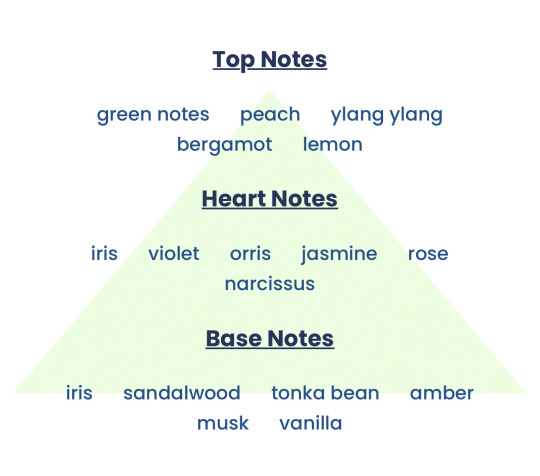
Basenotes.com: Green notes, peach, ylang ylang, bergamot, lemon, iris and orris, violet, jasmine, rose, narcissus, sandalwood, tonka, amber, musk, and vanilla.
—and you've got a powdery-nectar sandalwood bubblegum. It's so good. Two birthdays ago, I got myself a wide-ranging set of essential oils, just so I could see what things smell like individually; the night after I tried Samsara, I started messing around with them, and it's 10,000% the ylang that's bringing the strange fruity note. I rarely if ever see anyone mention the ylang-ylang in Samsara—they always talk about how strong the jasmine is, but I SWEAR TO YOU that this is what it does on me. In fact, twenty minutes in, Bubble Ylang was mostly what I was smelling.
At the same time, the fresh EdT was really, really powdery—you see iris there in not one but two levels of the note pyramid, and orris is just iris root. The classic Guerlains use the ionones of iris and violet a lot; they're in the house accord, the Guerlinade, which I may also try to get a sample of. But the powder is so much stronger in Samsara than I expected. I was promised a sandalwood overdose, and I'm sitting here with Juicy Fruit floating over a bed of irises—like the row of cool dark purple ones we had lining our driveway when I was a kid—at the half-hour mark. According to my notes, I didn't really get ~sandalwood until an hour-twenty, and even that was still blurring into the ylang-ylang. (Apparently these two notes are really compatible; it's the only thing same combination I liked in Chanel No. 5.) That said, it's lovely and sweet and easygoing if you APPLY SPARINGLY. Of the three Guerlains I've tried, this one was by far the easiest to wear.
Which is wild, because supposedly, Samsara is A Sandalwood Bomb, a true big-hair fume of the '80s that will choke you out of a room. And yet, I didn't even get the sandalwood clearly until more than an hour in. There's two reasons for this, I discovered:
One is that I microdose perfume. I always point this out because I want you to understand that if you apply more fragrance than I do, you are not going to get the tame results I do. If you spray Tyrannosaurus Rex all over yourself, there is nothing god or mortal can do for you. I used two swipes of the Samsara sample wand on my left wrist—and it did project a good bit, but it was comfortable. If I'd done the same on my right wrist to balance it out, I would have considered myself good to go for a perfume-appropriate occasion. Maybe if you didn't deploy FIVE SPRAYS you wouldn’t be choking on it, idk idk.
The other reason is that the current formulation of Samsara uses Australian sandalwood—whereas the original used a much richer Indian variety. I was surprised to discover that Samsara has always been formulated as a meeting of natural and synthetic sandalwoods, though. But the current version has a newer synthetic: Javanol. And the thing about Javanol is that some people can't smell it. And I may be one of them. Because there is no reason "an overdose of sandalwood" should smell this modest to me, in the same perfume that is shouting white floral, unless I physically cannot perceive its loudest component. But I'm smelling some sandalwood; that must be the natural oil.
For more on Javanol, I turn to a fragrance I haven't actually tried yet: Escentric Molecules' Molecule 04. Javanol is, in fact, that molecule. The product website explains, it's a synthetic that
retains the radiance and endurance of natural sandalwood, but is sheer and transparent like no sandalwood in nature.
“What I love about Javanol is its almost psychedelic freshness,” says [creator] Geza Schoen. “It smells as if liquid metallic grapefruit peel were poured over a bed of velvety cream-coloured roses.”
Javanol is like Iso E Super, the molecule in Escentric Molecules 01, in some ways. Like Iso E Super, it comes and goes. The person wearing it loses the ability to smell it after a short while, only to re-connect with it later.
Well, "it comes and goes" may be why I'm not smelling as much sandalwood in Samsara as advertised, I guess—maybe I’m not totally anosmic to Javanol? The company that makes it, Givaudan, says that the aromachemical has
a rich, natural, creamy sandalwood note like beta santanol combined with some rosy nuances. It can also be used at very low dosage (below 0.1%) to bring richness and creaminess to all types of accords. With its exceptional low threshold, Javanol™ is approximately 8 times more effective in wash tests than the most powerful sandalwood product. [...] In the quest for the perfect Indian Sandalwood, Javanol™ is probably the most versatile note with its power, radiance, woodiness and rosiness, blending perfectly with flowers.
Javanol blends so perfectly with ylang and jasmine, in fact, that I can hardly distinguish it through most of Samsara's lifespan on my skin (I appreciate a good olfactory chimera, so that's fine). I can also see why you'd reformulate Samsara, already famous for its Godzilla-sized projection, with the biggest, loudest synthetic sandalwood on the market. But the thing is, the Beast of Givaudan wasn't created until 1996. Javanol may be what Guerlain has paired with Australian sandalwood nowadays, but my original sample was made with [probably a mix of synthetics including] Givaudan's Sandalore and the good stuff—20% (!) Mysore sandalwood.
Mysore Sandalwood Oil is a trademarked perfume oil extracted from the Santalum album variety of sandalwood tree (also known as a "royal tree") in the Mysore district of Karnataka, India. The tree species is said to be one of the best varieties in the world. (Wikipedia, the most concise explainer)
It's also the most expensive. But while I'm sure reformulations are a cost-cutting measure, sandalwood sustainability has also become a huge issue; I'm happy with synthetics if it helps the cause. The Australian sandalwood used in the current Samsara seems to be a popular and less-threatened natural option; it's also in two other fragrances I'm trying at the moment, Le Labo's Santal 33 and Tom Ford's Santal Blush. But it's like the difference between tulle and velvet. You can still use it beautifully, but there is a smoothness and a weight that's missing. People say that Mysore sandalwood is "creamy," even sweet, and it is, but not in a dairy or dessert way; it's legitimately this kind of olfactory texture that's so good. By contrast, the scent of Australian sandalwood feels a little harsh in the top of my nose, full of wood grain and pencil shavings, but also lighter. And yet it blends just as well with the notes of the new Samsara, just in different ways.
As for the old—Mysore and Sandalore® were what greeted me when I uncapped my vintage, 34-year-old sample:
oh my god. ohhhhh my gooooood.
That big sweet fruity ylang-ylang immediately bounced right out—how had I only smelled jasmine in the vial before? I'll stop here and tell you a little bit about ylang-ylang, which is not the note I was expecting to go on about, but here we are:
When you hear about "white florals," they're generally talking about jasmine, gardenia, tuberose (you'll remember this one from HYPNOTIC POISON), lily, lily of the valley—and ylang ylang, even though the latter is a showy yellow flower. I truly don't know how to describe the White Floral if you're not familiar with it, especially since I've never perceived any funky "animalic" indole notes. It's just good to me, very rich, very perfumy, and apparently it does, in an aromatherapy context, have a slightly sedative effect; this may be why people talk about "narcotic" white florals. Ylang-ylang takes the woozy richness of jasmine and, uniquely, adds that fruity, slightly spicy, banana-esque note; I'd love to look for the differences between white florals as I try out more fragrances. With Samsara(s), the jasmine doesn't seem distinct to me, serving instead to support the ylang-ylang, and maybe this is why I only smelled jasmine in the vial: it's my skin chemistry, once again, that's playing favorites.
You know what else my skin apparently loves? Expensive vintage sandalwood. The original Samsara skipped straight to the 1:20 mark and—speaking of narcotics—hit me like a tranquilizer dart. I just curled up on my bed and held my wrist to my nose for about an hour. I was like a cat on the 'nip. My God. I had some hand-me-down incense sticks from the '70s when I was a teenager, and I have been chasing that sandalwood high for three decades. This is it. The blanket of iris, the bergamot blast other reviewers talk about (I only got it the third time I wore the EdT), the supporting cast of notes—barely there. Just the gold.
For about two hours, it was amazing. Then, gradually, Samsara grew more and more overpowering, like a rogue science project slowly ballooning out of control. I ended up wiping it off with a little jojoba oil—not washing it off (DON'T WASTE IT!!), but reducing the amount I had on. There's only about two drops, thick as maple syrup, left in that vial, and that's fine.
Meanwhile, every time I wear the current eau de toilette, it disappears after about three hours.
I wish I'd been able to get a current EdP sample to compare the two formulations directly. But you know what? I still enjoy the iris-forward, sandalwood-backward Samsara. It's easy to wear and it doesn't overstay its welcome, which is a good thing for someone with fragrance sensitivities (me). As much as I love the smooth golden Mysore aspect, I'd rather have the option to reapply than be trapped with the Sandalwood That Ate 1989.
Perfume discussion masterpost
#perfume#perfume discussion#perfume: guerlain#the beast of givaudan#note: sandalwood#note: ylang ylang#note: iris#note: white florals#note: javanol#long post
144 notes
·
View notes
Text


Dolores del Rio holding a huge bottle of Mitsouko perfume, 1920s
135 notes
·
View notes
Text
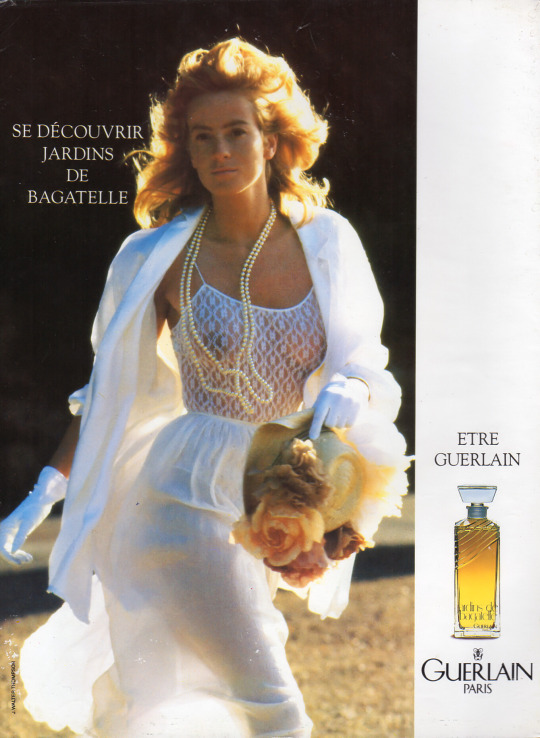
Jardins de Bagatelle by Guerlain, 1986.
Model: Hester Wentzel.
57 notes
·
View notes
Text
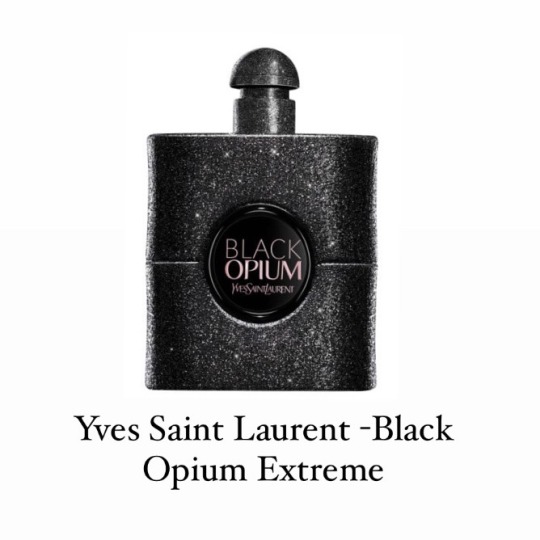
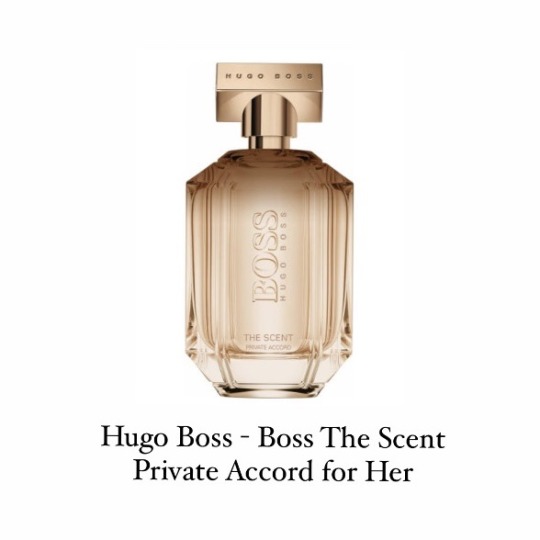

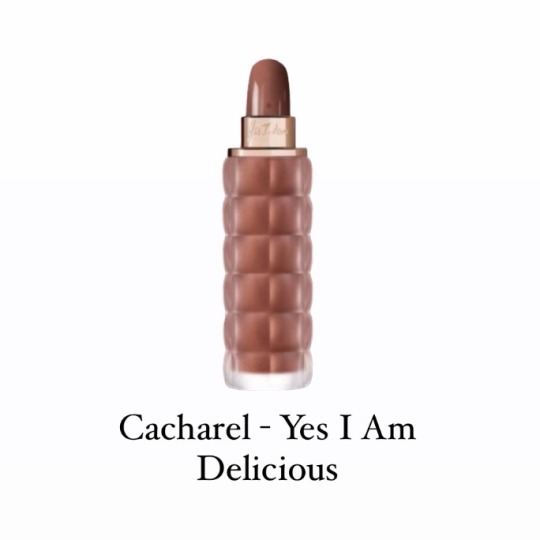
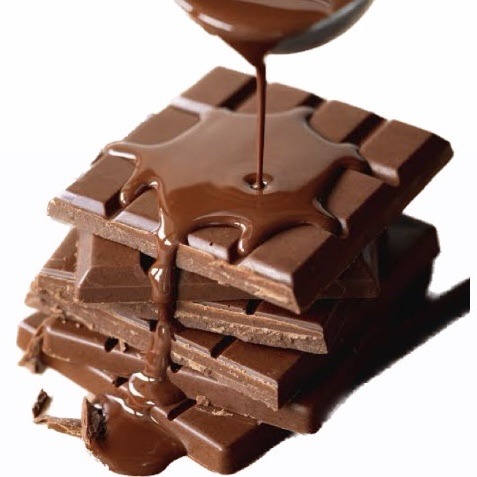
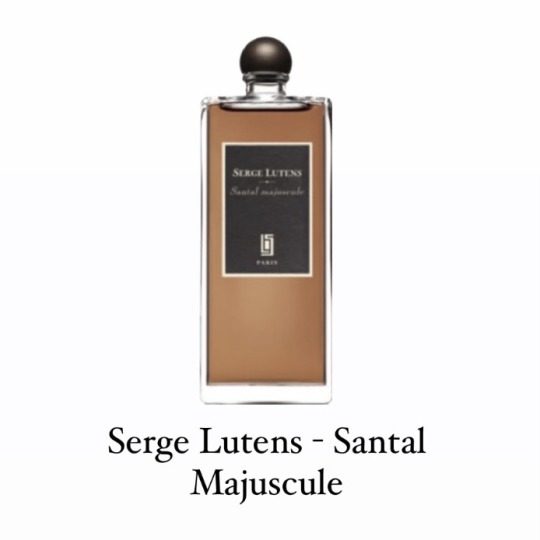
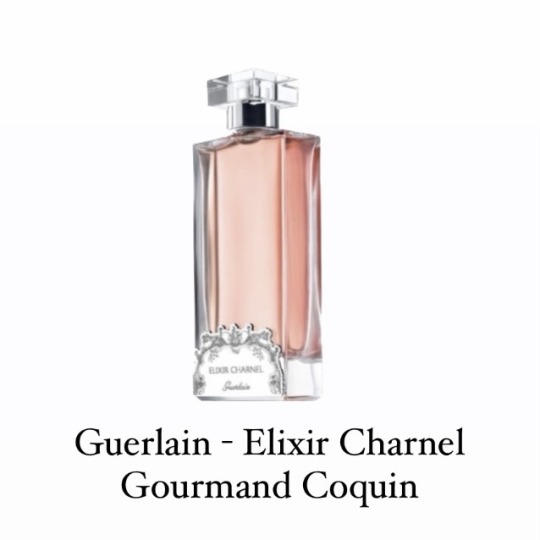


Best Chocolate/Cacao Perfumes🍫
#aesthetic#perfume#chocolate#dessert#girlblogger#wishlist#cacao#scent#fragrantica#fragrence#makeup#perfumes#ysl perfume#yvesrocher#hugo boss#guerlain#gourmand#moodboard#soft moodboard#stargirl#winter#cozy#taurus
288 notes
·
View notes
Text

gentlemen prefer blondes (1953)
65 notes
·
View notes
Text
scent(s) of the day: insolence EDP/EDT (guerlain)
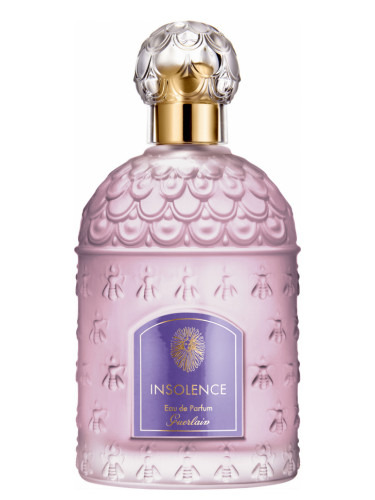

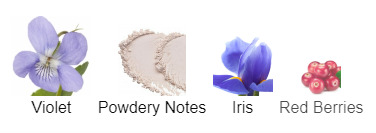
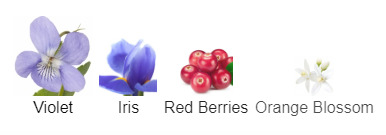
today we have a double-feature, since these are essentially the same fragrance!
insolence EDP reminds me a little of dryer sheets, it has that clean powdery smell. i do get a fair amount of violet, but mostly at the back of the nose on an exhale; ionones love to play coy like that. the red berries are prominent in the first moments, and then the iris unfurls and creates that scent of vintage cosmetics, romantic and a little dusty. this scent is quite demure, not really bratty and loud. it definitely carries the guerlain fingerprint i dearly love: that luminous warmth at the heart of the fragrance that i find really hard to describe but that is also present in l'heure bleue and après l'ondée. (side note: i need to get my hands on a pure sample of the guerlinade accord, for research purposes.) today is rainy, and violets feel apropos. alas, the EDP fades really quickly. 4h - 5h after application it's all gone; even before that it sits very close to the skin.
the insolence EDT is brighter, soapier, an octave higher in pitch; it smells refreshing, modern and a tad less powdery than the EDP, but still very violet-forward. i'm unsure which reformulation of both scents i own, but i can detect an orange blossom note in the EDT that makes it sunnier and more open, complementing the glowing guerlain heart notes very well. oddly enough it's stronger in sillage than the EDP on my skin. i think i might prefer it? i do enjoy the vintage melancholy vibe of the EDP as well, so it's hard to pick a favourite.
51 notes
·
View notes
Text




pink perfumes 🎀💫
11 notes
·
View notes
Photo
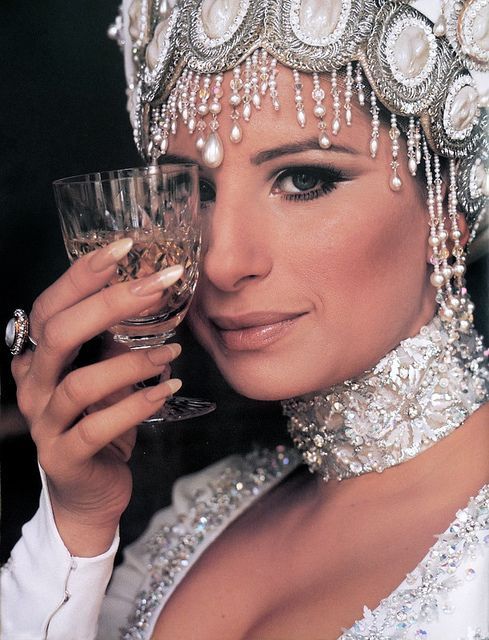
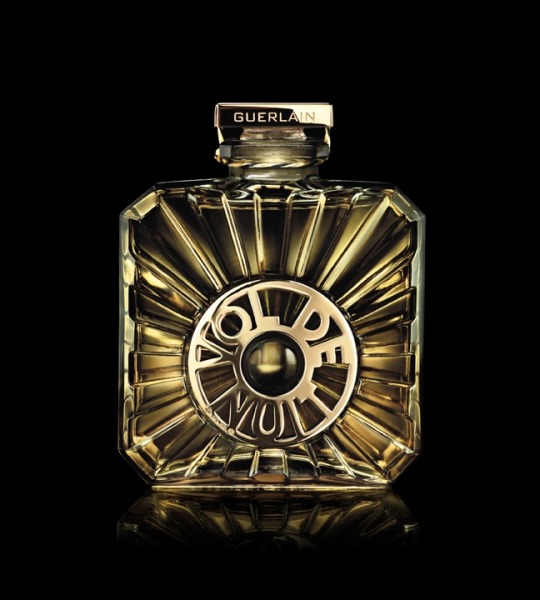
Barbra Streisand, born the daughter of a soprano who failed to follow her dreams of becoming a star, and a high school teacher, first started showing her immense talent at age thirteen. Known on her block as “the girl with the good voice”, it was her biggest dream to be an actress. After years at singing at clubs (she famously entered a competition at The Lion, a gay nightclub in Greenwich village) and acting on Broadway, Streisand’s first film would be an adaption of one of the plays she starred in--”Funny Girl”. It was a success, and thus began the career of this legend.
Barbra’s preferred scent is Vol de Nuit by Guerlain--a fragrance that first debuted in 1933. It is an ethereal and delicate perfume, woodsy and green and very narcissus forward.
Vol de Nuit has top notes of Galbanum, Narcissus, Bergamot, Orange Blossom, Lemon, Orange and Mandarin Orange.
Middle notes are Iris, Narcissus, Aldehydes, Vanilla, Violet, Indonesian Carnation, Rose and Jasmine.
The base notes are Oak Moss, Orris Root, Sandalwood, Spices and Musk.
51 notes
·
View notes
Text

#shalimar#parfum#perfume#fragance#fragancia#guerlain#paris#guerlain paris#france#francia#europe#europa
25 notes
·
View notes
Text

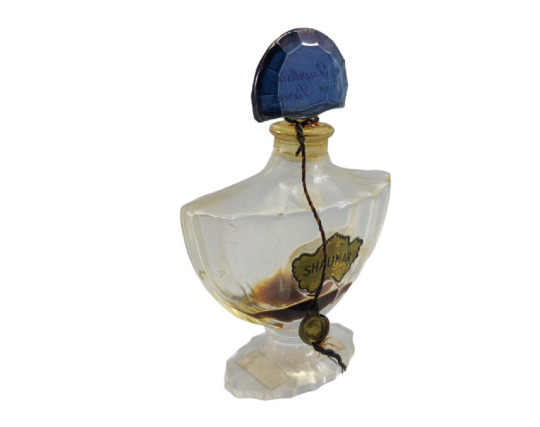
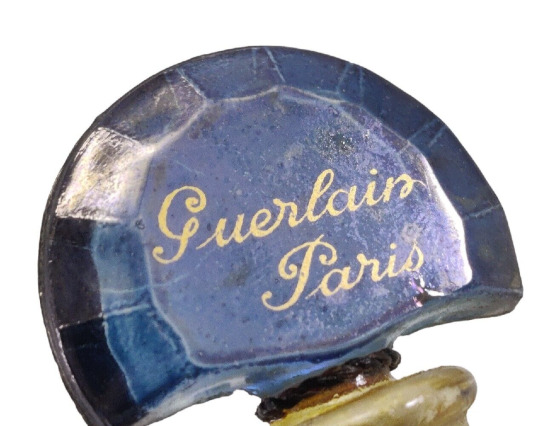



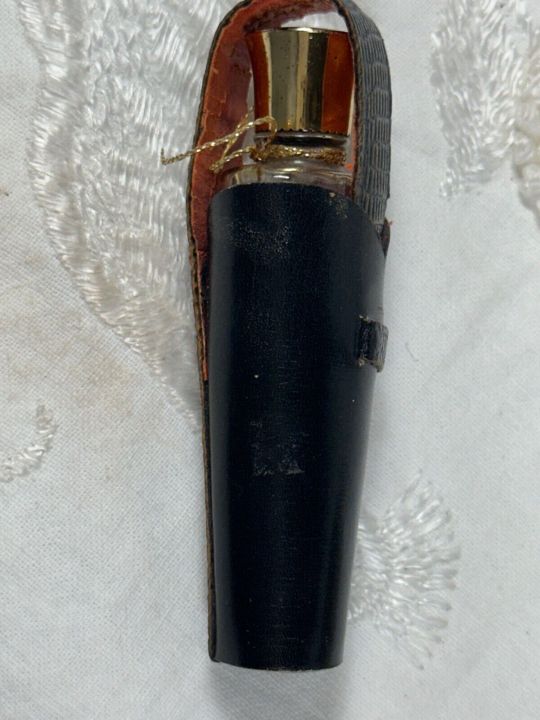
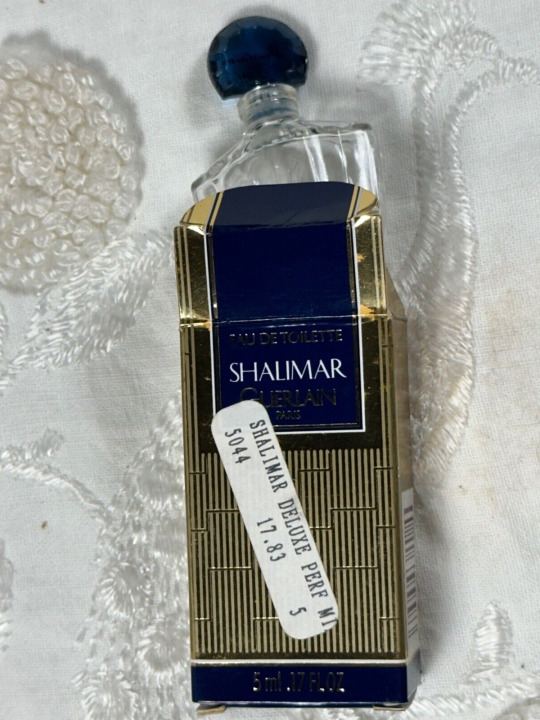


Vintage Guerlain Paris Shalimar Extrait de Parfum Perfume Bottle ebay jaded200916
5 SHALIMAR PERFUME CRYSTAL BOTTLES BY GUERLAIN PARIS, DISPLAY BOX, Purse Case ebay justchecken
19 notes
·
View notes
Text
mandarin/basil is such a good scent combination so i keep buying things supposedly with that scent only to be disappointed again and again because it hardly ever actually smells like that. Or it does momentarily and then fades into something unpleasant
8 notes
·
View notes
Text
Mitsouko (Guerlain, 1919)
Guerlain, 1919, Jacques Guerlain. Post-2014 formulation; eau de parfum concentration; 2002 decant from the Perfumed Court.
(To discuss: what it smells like, why it smells like that, and the struggle to describe this legendary heritage throwback.)
Trust me, these specifications make a difference. A year ago, I read reviews of different versions and took notes on what I wanted:
Do not get samples from 2007 - 2013, pre-2007 will have real oakmoss. Every concentration has different focus. EdP is mellower than EdT. Extrait is "truest."
You see, the International Fragrance Association (IFRA) restricted oakmoss in 2001, and then more tightly in 2009, from what I can tell. Mitsouko is considered a "reference chypre," a textbook example of the genre, and chypres are, by definition, citrus (usually bergamot), labdanum, and oakmoss. (The Perfume Society adds patchouli to this trio.) Like, you gotta have those for it to be a chypre. But Mitsouko is not THE chypre:
Bois de Jasmin: Guerlain Mitsouko : Fragrance Review (New and Vintage):
Created by Jacques Guerlain in 1919, Mitsouko was a variation on the avant-garde fragrance of the period–Coty Chypre. Chypre was based on the startling contrast among the bergamot top notes, the jasmine heart and the richness of oakmoss. Though undoubtedly beautiful, Chypre was brutal in its impact. […] Mitsouko is a kiss to Coty Chypre’s slap in the face, and for this reason, its popularity endures to this day.
So when oakmoss was restricted as an allergen in the 2000s, perfumers industry-wide scrambled to come up with a facsimile; for Guerlain, with a fragrance this storied, failure was not an option. Reformulations everybody hated were, though. Edouard Fléchier took a crack at it somewhere around 2007, and in 2013, Thierry Wasser reformulated the whole thing to recapture the scent everyone remembered. People seem to have been satisfied with that version since.
So I've worn that new Mitsouko on and off, when I feel fancy, for about a year now. I put a little on a card for my sister to smell the other week, and she said, "It smells old." (She'll be the first to tell you that she’s learning what individual notes smell like.) Being crushingly literal, I don't understand what "smells old" or "smells like old ladies" means. Powdery, she said, struggling to explain. "Old." Maybe I haven't smelled enough old ladies.
Mitsouko does smell… weird, by modern standards. Generally, people either love it or hate it, and Results May Vary in a big way; it's worth getting a sample just to take it for a spin (kind of like Not A Perfume or Glossier's You, in that one regard), and to see what a piece of history smells like. Expert-of-experts Luca Turin says it's the one perfume he'd take to that proverbial desert island, but I am but a gentle woodland creature, a basic vanilla bitch; I would be more likely to take something that cost $10 instead of $145. But I still kind of love Mitsouko. Users who review it positively often speak of not liking it at first, then going back to it again and again. They also speak of a "pissy" stage in the middle that might be civet or oakmoss (or whatever represents those notes now); I know what they're talking about, but it doesn't read as anything so unpleasant to me. It's not easy to wear like the simple scents I usually go for, but the drydown is absolutely gorgeous. That's one of the things that makes Mitsouko so interesting to me: it's like two completely separate perfumes were mingled, and the first gradually recedes to let the Guerlinade take center stage.
But what’s in it? “La Guerlinade,” for starters, is a complex foundation that the historical Guerlains have—a house accord. (You could buy it unto itself for a while.) The exact formula is super secret, of course, but it's said to (possibly) include bergamot, jasmine, rose, orange blossom, orris, vetiver, tonka bean, vanilla, and lilac. The lilac—a note I didn't even know I would like—is what shows up on me with both Mitsouko and Guerlain's L'Heure Bleue (1912); it's a soft light purple note that peeks through from the very beginning, and gradually becomes the glass slipper that Cinderella leaves behind.
Over on the official Guerlain site, they tell us a bit more about the reformulation:
A masterpiece in balance and originality, Mitsouko combines a fruity peach note with jasmine and rose centifolia (May rose) flowers. Its mysterious base combines spicy notes with notes of undergrowth and vetiver.
Warm spices such as black pepper mingle with cold spices like cardamom and pink [pink pepper?] berries.
Patchouli essence features many vegetal, woody and earthy olfactory facets. Combined with rose, moss, and bergamot, patchouli forms the base of the chypre accord.
Hilariously, Guerlain also straight up tells you what Thierry Wasser actually put in New Mitsouko:
ALCOHOL
PARFUM (FRAGRANCE)
AQUA (WATER)
LIMONENE
LINALOOL
EUGENOL
HYDROXYCITRONELLAL
EVERNIA FURFURACEA (TREEMOSS) EXTRACT
CITRAL
BENZYL BENZOATE
ALPHA-ISOMETHYL IONONE
CITRONELLOL
GERANIOL
BHT
HEXYL CINNAMAL
CINNAMYL ALCOHOL
ISOEUGENOL
BENZYL ALCOHOL
BENZYL SALICYLATE
TOCOPHEROL
CI 14700 (RED 4)
CI 19140 (YELLOW 5)
CI 60730 (EXT. VIOLET 2)
FARNESOL
Yeah. There's the famous Guerlinade… in there somewhere. They gave that secret away, hidden under a tiny link, because it means fuck-all without proportions or a way to separate it from the composition as a whole. Well played.
A Basenotes user posted a suggested Mitsouko formula that's somewhat more indicative of what those chemicals would smell like (deep breath): sweet orange, lemon, bergamot, elemi, celery seed, tarragon (a component of oakmoss reconstitution), coriander, chamomile, lavender, geranium, ylang, jasmine, clove, anise, castoreum, civet, labdanum, tonka, patchouli, cinnamon, peru balsam, benzoin, vanilla, violet, rose, costus, vetiver, musk, and the famous "aldehyde" C-14: a peach-scented lactone from 1908.
Logically, Mitsouko (1919) must not have been the first fragrance to use gamma-undecalactone, but I'm not sure any other has survived the ages like this one. Carter Burr (another top expert) writes that Jacques Guerlain most likely got it from the supplier Firmenich, via their Persicol peach base:
C-14 was a marvel, a fruity, aromatic, delicious scent that gave ripe peach skin. Guerlain plugged C-14 into the equation perfectly (the rumor is, actually, similar to Chanel 5, that he in fact accidentally overdosed the stuff; who knows), and Mitsouko became a thing of subtle opulence, strength and balance and silken twilight.
Sidebar: peach is one of my favorite fragrance notes. It's in Tamora, one of the first BPALs I ever tried twenty years ago; I don't know what the actual peach accord in that oil is, but it's still probably my favorite Black Phoenix. No matter how weird people said Mitsouko was, I was GOING to try it for that landmark peach lactone. And that's what shows up at first for me. I do get that Guerlinade lilac peeking through, but the opening as a whole is a spicy autumnal peach lying on the dead-leafed forest floor, more velvet than flesh, Octoberish and unseelie. That first sequence is intriguing, and then it warms up into that unpleasant stage; then that uneasy note fades and the Guerlinade comes fully out, a soft pale purple-blue siren song floating by on a powdery cloud. Those are the two perfumes that seem to be twined: bewitchingly different, each one blended so smoothly that I can't distinguish all the notes within them, yet not quite blended together.
And that's just my own reaction. Watching Fragrantica reviewers describe Mitsouko is a pastime unto itself. It smells like power, sex, domination, old money, "strangely nutty," depressing, elegant, fascinating, bitter, ripe, like oil paint, "an old medicine cabinet," pungent, tangy, moldy, intoxicating, alienating, feminine, masculine, unisex—to quote frugally:
User Aerides: "Mitsouko is gloomy Sundays, walks in the woods after it rains, and empty auction rooms. […] It's incense and burning candles, and waxy floor polish. It's cinnamon peach jam. It's a bouquet of lilacs on the dining room table. It lasts so long it's like a ghost in the room."
User Amararata: "There is something vampire-like about this fragrance. It's the sort of scent a woman leaves behind after she's conquered a man, or a kind of lascivious tryst in the middle of the day."
User querty988: "For some reason, those stinky little [camphor-clove] whiffs endeared it to me. It was like the baby from Eraserhead whispering in my ear, 'yes, I am the most revolting thing you've ever smelled, but I'm here with you in public today, and it's our little secret that I belong to you.'"
User KingRidesBy96: "Can't explain it. Don't want to. She's a witch, it's magic."
Mitsouko is weird as hell, and yet, thanks to the “waxy floor polish” review, and (I swear) a review someone wrote that I can't find now that mentioned linseed oil, furniture, paint, and his wife, I knew exactly what Mitsouko was going to smell like. And I was right. And I think that the mental preparation is incredibly important here. Not to be snooty about what it takes to "appreciate" a perfume like this, but to frame for you where this being of times past is, at least, coming from. Mitsouko is Aslan, present when the Deep Magic was written in 1919, whether the Deep Magic smells good on you or not.
Further reading linkspam
Bois de Jasmin: What Does The Word Mitsouko Mean?
It’s the French spelling of a female Japanese character’s name (Mitsuko, “child of light,” “shining child”) from the 1909 French novel La bataille (“The Battle”); Jacques Guerlain was friends with the author, Claude Farrère, so this is thought to be the most likely namesake. Wikipedia:
The novel is set in Japan during the 1905 Russo-Japanese War, and chronicles a fictional amour fou between a British Navy Officer and one "Mitsouko", the wife of Fleet Admiral Marquis Yorisaka. Both Yorisaka and the British officer sail to war, and Mitsouko awaits with reserve to see which of the two will return alive to her.
Maybe this is reflected in the duality I’m getting from the perfume, I don’t know.
Isn’t all this very orientalist? Why, yes! Our antique faves are as problematic as ever!
Ayala Moriel: Olfactory Orientalism
Arts of the Working Class: Journey with Mitsouko and Mitsuko
More technical discussion:
Persolaise Review: Mitsouko from Guerlain (Jacques Guerlain; 1919 [and Thierry Wasser; 2013/14]):
Suffice it to say that whether it’s because [Wasser] increased the dosage of vetivert in the base, or he revitalised the citruses at the top, or, most interestingly, he created a special ‘oakmoss-like’ accord to compensate for the shortcomings of synthetic substitutes, the result is that the current Mitsouko feels like it has just emerged from the fountain of youth.
The Empress of Moss: Mitsouko
A look at the current state of the chypre: IFRA, Oakmoss, Chypres & Perfume Houses (2022)
Late breaking news: right after I fell down the stairs and injured myself rather thoroughly yesterday, my vintage pre-oakmoss-ban Mitsouko sample arrived in the mail. I’ll update once I can smell it. I also have a 2022 decant of L'Heure Bleue and, uh, about three drops of Samsara from around 1989, so stay tuned for more Guerlain at some point.
#perfume#perfume discussion#perfume: guerlain#welcome to hell it's my blog#long post#text post#ridiculously deep dive#special interests
108 notes
·
View notes
Text
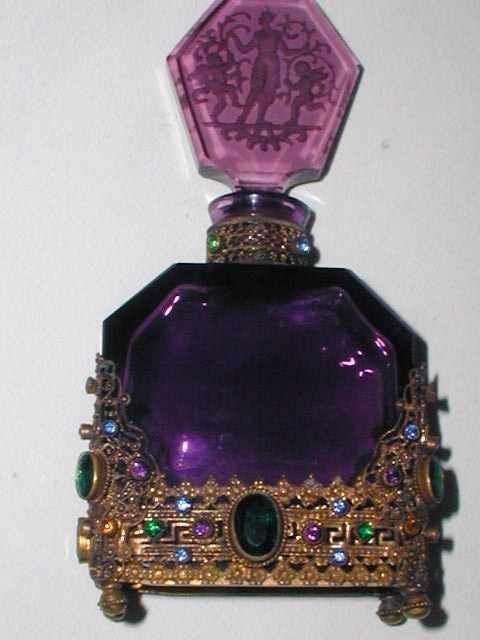



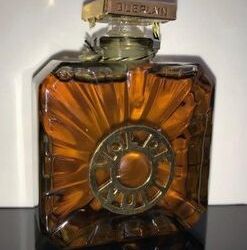

"As a collector of beauty accoutrements, I have long been inspired by unusual and rare perfume bottles from the 1920s and 1930s. What variety! Flacons of faceted ruby or blue cut glass. Those embellished with hand-painted flowers or pretty ribbons. Figural bottles. Crystal ones! Atomizers with long tassels. There is something so elegant, so luxurious about them. What can I say? A decorative bottle makes me happy."
-Dita von Teese
#perfume#perfume bottle#vintage perfume bottle#vintage#dita von teese#quote#guerlain#shalimar#vol de nuit#salvador dali
378 notes
·
View notes
Text
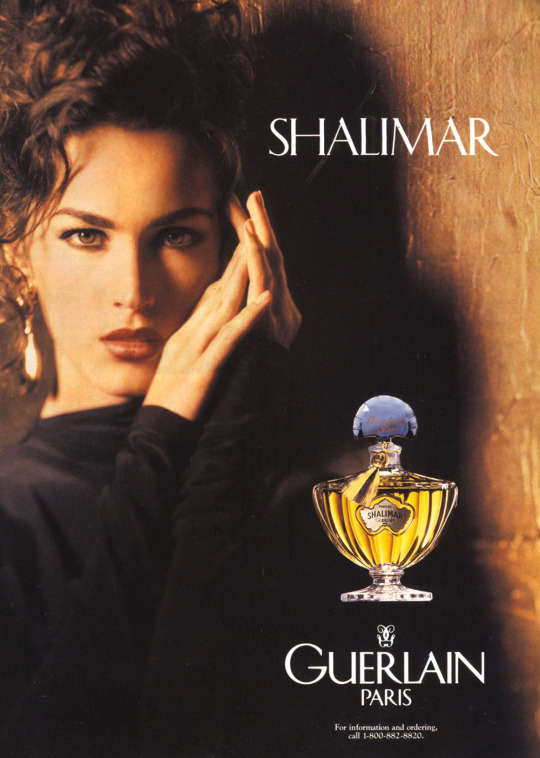
Shalimar by Guerlain, 1991.
Model: Ruvé Watts.
26 notes
·
View notes
Text

A vintage Baccarat crystal bottle of l’Heure Bleue, from the late 1920s. Amazingly that brown sludge at the bottom still smells fantastic, I don’t know how it’s possible, but it does.
#Guerlain#l’Heure Bleue#perfume#fragrance#parfym#fragram#scent#Jacques Guerlain#Catherine Deneuve#Queen Elizabeth II#Baccarat#Vintage Perfume#Beauty
6 notes
·
View notes
Text
Have you smelled this perfume?
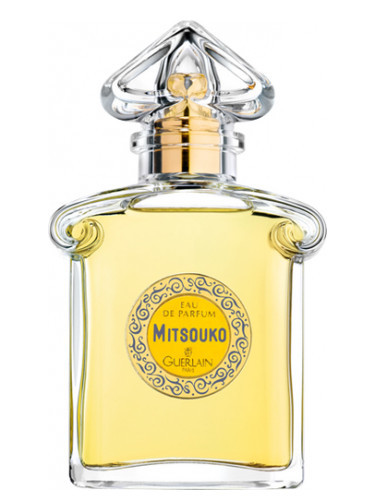
Hailing from the storied fragrance house of Guerlain, Mitsouko is a sweet and earthy chypre fragrance. She doesn't look a day over 80, but she is in fact 100 years old! Read more at Fragrantica.
#mitsouko#Guerlain#guerlain perfume#fragrance#designer fragrance#classic perfume#designer perfume#french perfume#perfume nerd#fragrantica#have you smelled this perfume#have you poll#poll
13 notes
·
View notes